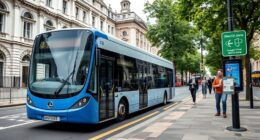In Scandinavia’s cold climate, electric buses face range reductions of up to 40% and longer charging times, impacting schedules and energy efficiency. Cold weather slows battery reactions, so you need effective thermal management, pre-heating, and insulation to maintain performance. The buses’ even weight distribution and low centers improve safety on icy roads. If you want to understand how transit agencies adapt to these challenges and optimize operations, there’s more to uncover about their strategies.
Key Takeaways
- Proper thermal management and pre-heating systems are essential to maintain battery performance in Scandinavia’s cold climate.
- Electric buses benefit from even weight distribution and low centers of gravity, enhancing safety and stability on icy roads.
- Range decreases significantly in cold weather, requiring strategic route planning and more frequent charging during winter operations.
- Insulated compartments and robust infrastructure are vital to protect batteries and ensure reliable operation in extreme cold.
- Transit agencies adapt by optimizing heating systems, scheduling maintenance, and redesigning routes to address winter weather challenges.

Electric buses are increasingly popular for their environmental benefits, but extreme weather conditions pose unique challenges. If you’re operating electric buses in cold climates, you’ll notice that their range diminishes considerably during winter. Cold temperatures demand extra energy to heat both the cabin and the batteries, which reduces the energy available for propulsion. This isn’t just a minor inconvenience; studies show a 30-40% decrease in range during extreme cold, meaning you need to plan routes carefully to ensure buses can complete their trips without running out of charge.
Extreme cold reduces electric bus range by 30-40%, requiring careful route planning and energy management.
Energy efficiency in electric buses peaks at moderate temperatures, around 55°F to 60°F. Unfortunately, Scandinavian climates often fall below this range, especially during winter months. When temperatures drop, chemical reactions within batteries slow down, leading to decreased performance and further reducing range. This means that your buses mightn’t only run shorter distances but could also take longer to recharge, complicating scheduling and increasing operational costs. You’ll need to account for these factors when planning routes and bus deployment during colder months.
The good news is that electric buses have advantages in snowy conditions. Their even weight distribution enhances stability, providing better traction and control on icy and snow-covered roads. Drivers often report feeling more confident handling these buses in winter, thanks to their lower center of gravity and balanced weight. This improved stability can translate into safer driving conditions, especially in areas prone to snow and ice.
However, proper maintenance becomes critical. Ensuring batteries are protected from extreme cold through insulated compartments and pre-heating systems helps maintain ideal performance. Adequate charging infrastructure, especially fast-charging stations equipped to operate efficiently in cold temperatures, is essential to keep buses ready to service routes reliably. Additionally, battery performance in cold weather can be significantly improved with proper insulation and pre-heating strategies. Implementing thermal management systems can further optimize battery life and performance during winter months.
Operational adjustments are crucial in such climates. Schools and transit agencies must strategize route planning, factoring in reduced ranges and longer charging times. This might involve scheduling more frequent charging stops or redesigning routes to avoid overly long trips on cold days. Additionally, efficient heating systems in buses are essential to minimize energy loss, allowing more energy to be directed toward propulsion rather than cabin heating.
Proper maintenance routines, including battery checks and insulation, help sustain performance throughout the winter. While Scandinavian climates present challenges, they also showcase how electric buses can adapt and thrive with the right infrastructure and planning. The importance of cold-weather vehicle maintenance cannot be overstated in these environments, as it ensures consistent performance and safety. The environmental benefits align well with regional policies, and technological advancements continue to improve cold-weather performance.
As you operate or plan to deploy electric buses in areas with extreme weather, understanding these impacts and preparing accordingly will ensure safer, more reliable service despite the harsh conditions.
Frequently Asked Questions
How Do Electric Buses Handle Snow and Ice Buildup on Roads?
You might wonder how electric buses handle snow and ice buildup on roads. They use specialized equipment like heated pantographs and thermal insulation to prevent ice from forming and guarantee reliable charging.
Operators also upgrade infrastructure, such as heated stations, to maintain efficiency. Despite challenges, these measures help electric buses navigate snowy, icy conditions effectively, keeping public transport running smoothly while minimizing disruptions.
What Are the Costs Associated With Maintaining Electric Bus Fleets in Cold Climates?
When maintaining electric bus fleets in cold climates, you face costs like higher infrastructure investments for charging stations and thermal management systems.
While maintenance costs are lower—about $0.64 per mile—you may spend more on auxiliary heating and battery preconditioning to keep buses operational.
Additionally, cold weather can reduce range, requiring mid-day charging and careful planning, but long-term savings from lower fuel and maintenance expenses make it worthwhile.
How Is Passenger Safety Ensured During Extreme Weather Events?
Imagine a shield protecting passengers from harsh weather—that’s how safety is guaranteed during extreme events. You rely on advanced temperature management systems, emergency protocols, and system redundancies to keep everyone safe.
Route adjustments, clear communication, and comfort measures further shield passengers from the cold. Regular maintenance and collaboration with authorities act as your safety net, ensuring passenger well-being even when the weather tries to throw a storm your way.
What Are the Challenges of Charging Electric Buses in Freezing Temperatures?
You face several challenges when charging electric buses in freezing temperatures. Cold weather can damage charging equipment and reduce battery efficiency, leading to longer warm-up times and decreased range.
Snow and ice around outdoor stations require regular clearance, and batteries need preconditioning to warm up, delaying charging.
To guarantee smooth operation, you should consider indoor charging solutions, robust equipment, and pre-trip routines that optimize battery and cabin warmth.
How Do Weather Conditions Impact Battery Performance and Longevity?
Weather conditions substantially influence your electric bus’s battery performance and longevity. Cold temperatures temporarily decrease capacity and range, but proper thermal management assists.
Hot weather accelerates battery degradation and diminishes range, especially beyond 70°F. To protect your batteries, store and charge in shaded or cooled areas, and follow operational protocols.
Staying aware of these factors guarantees your batteries last longer and perform at their best, even in extreme climates.
Conclusion
As you navigate the icy roads of Scandinavia, remember that electric buses stand resilient like the Norse ships of old, braving storms with unwavering strength. Their ability to perform in extreme weather mirrors the legendary resilience of the Vikings—adaptable and enduring. Embracing this technology means you’re part of a journey toward a sustainable future, where innovation and nature’s challenges collide like a timeless saga, proving that even in the harshest conditions, progress prevails.









